Dayton Power and Light
People (September 2013)
People (January 2009)
El Paso Electric (EPE) selected David W. Stevens as CEO. DPL Inc. promoted Frederick J. Boyle to senior vice president, CFO and treasurer of DPL and its principal subsidiary, The Dayton Power and Light Co. Great Plains Energy named Todd Kobayashi v.p., strategy and risk management. Consumers Energy promoted Richard J. Ford to vice president of energy delivery. And others...
People
(October 2007) J. William Ichord joined Sempra Energy as vice president of government relations. DPL Inc. appointed Frank F. Gallaher to the boards of directors of DPL and The Dayton Power and Light Co. The board of directors of NiSource Inc. elected Deborah S. Coleman, executive vice president and COO of the National Urban League, to the NiSource board of directors. And others...
Commission Watch
Commission Watch
Irregular seams affect ratemaking policies.
In a case that marks the first time the Federal Energy Regulatory Commission eliminated inter-RTO rate pancaking, the commission in late July issued an order terminating regional through-and-out rates (RTORs) charged by two regional transmission owners (RTOs)-Midwest Independent System Operator (MISO) and PJM Interconnection. The decision removes an estimated $250 million in yearly fees collected by those two entities.
Commission Watch
Is the "pathway concept" the answer to Virginia's qualms?
PJM, at its annual meeting, announced a plan to integrate ComEd into PJM by Oct. 1, pursuant to FERC's April 1 order, despite Virginia's saying no to membership by American Electric Power (AEP) or any other jurisdictional utility, according to PJM spokesman Ray Dotter. PJM introduced the "pathway concept" as a way to work around that state while the jurisdictional issues are being fought at FERC. (May 16 was the deadline for filings at FERC on whether the integration can proceed.)
Commission Watch
Is the "pathway concept" the answer to Virginia's qualms?
PJM, at its annual meeting, announced a plan to integrate ComEd into PJM by Oct. 1, pursuant to FERC's April 1 order, despite Virginia's saying no to membership by American Electric Power (AEP) or any other jurisdictional utility, according to PJM spokesman Ray Dotter. PJM introduced the "pathway concept" as a way to work around that state while the jurisdictional issues are being fought at FERC. (May 16 was the deadline for filings at FERC on whether the integration can proceed.)
Commission Watch
State PUCs Show Split Personality
While electric restructuring pauses, telecom pushes forward.
No matter which way they turn, state public utility commissions (PUCs) have their work cut out for them.
While federal policy-makers push ahead with wholesale market reforms in the electricity sector, many at the state level now call for a cautious approach to protect consumers.
People
Competitive Efficiency: A Ranking of U.S. Electric Utilities
Do mergers and "critical mass" really make a difference? The answer, it seems, is yes.
To become more competitive, U.S. electric utilities have embarked on a quest in recent years to improve operational efficiency and factor productivity. The question is: Are utilities making progress? And, which companies have gained a competitive edge? Which have not?
Industry analysts have long argued that given the structure of the markets they serve and their cost-based, rate-setting procedures, electric utilities tend toward monopolistic behavior.



